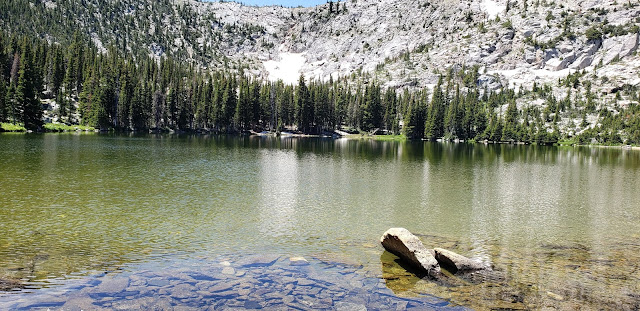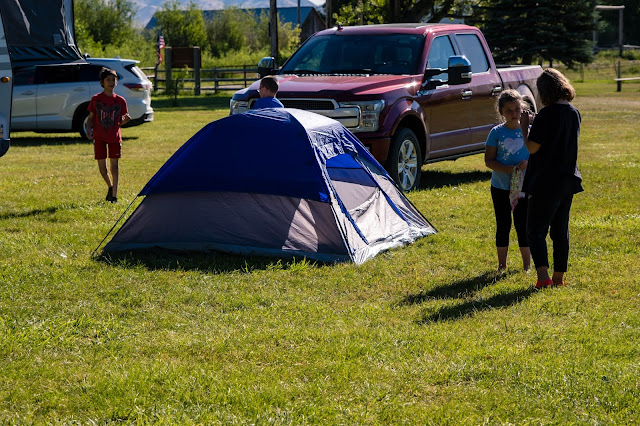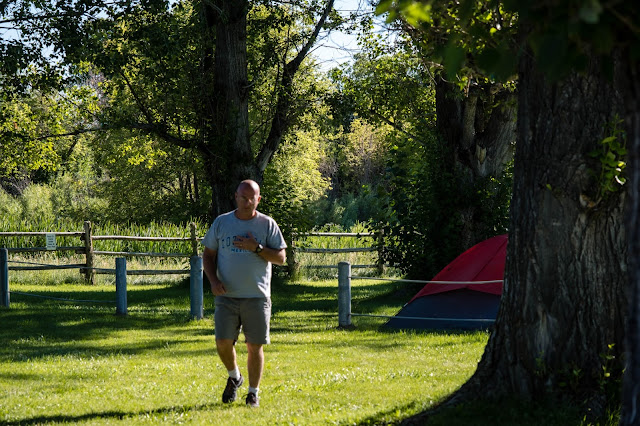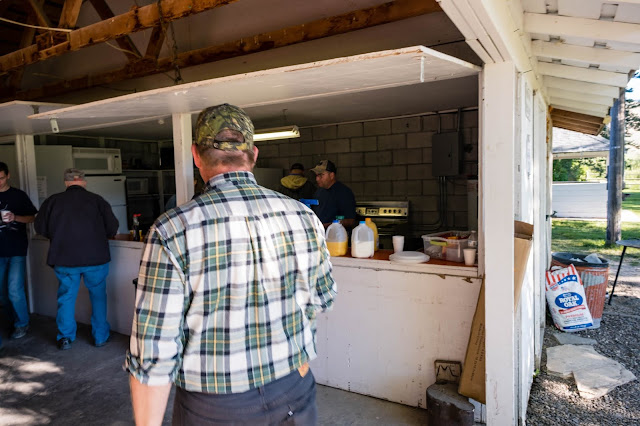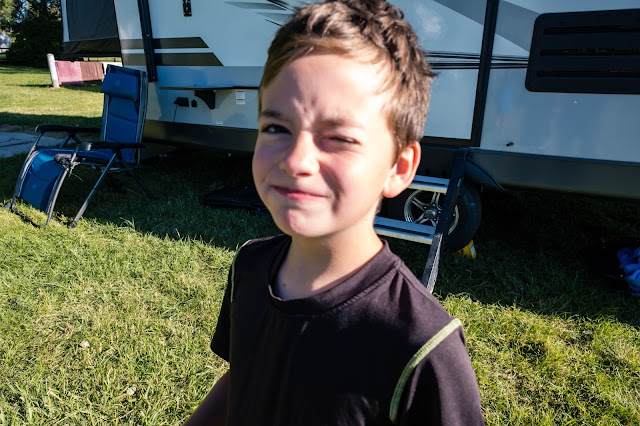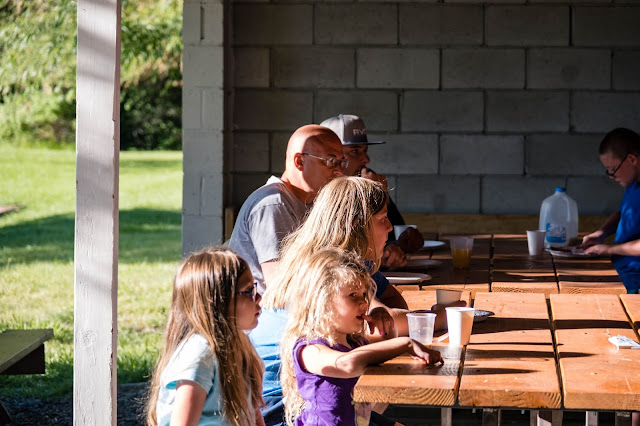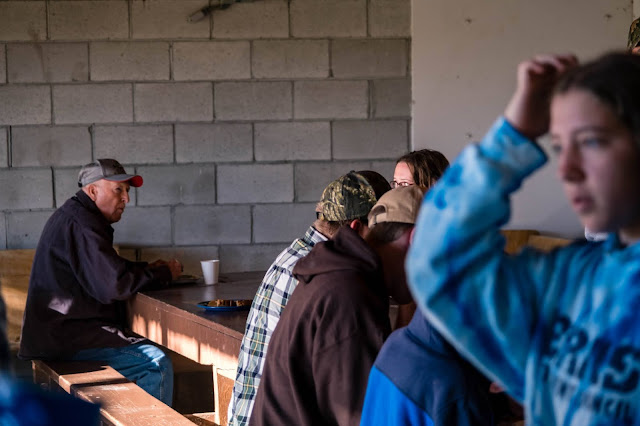I sent an email around to my family members and asked them if they had any memories of this particular area. The little stream is called Horsethief Creek and it flows into Antelope Creek on the right in the above picture.
"Is that blood on your knees?" Dad asked.
I had just shut the door to the frigid night air and turned around, where my dad and my brother, Hugh, were taking a break to get warm in the camper's heated interior.
I quickly looked down at my coveralls and winced. It had been dark for several hours already and l had forgotten that blood was smudged into the material covering my knees and shins.
Then he cried out, "You DID get an elk!"
Darn it! Until now, I'd given only vague answers to their questions and I'd managed to avoid telling them the best part of my day. I had wanted to tell the story properly, with all of the excitement and adrenaline, disappointment and despair. I wanted to see the looks on their faces when I reached the grand finale, and watch it transform into their own excitement and anticipation for tomorrow's hunt.
Still silent, and feeling a bit deflated, I looked back and forth at their wide, expectant eyes and, after a moment, shrugged with one shoulder and put them off, replying simply, "Yeah, I've got a cow down."
Despite their excited, and somewhat angry, prods, I refused to say another word until we were settled in for the night, our gear having been stowed and the horses were fed and out of the icy breeze drifting down from the frozen peaks. When we were finally seated in the warm camper, with our coats off and supper on the table, I looked at Dad and Hugh, making sure I had their full attention before I began.
Hunting High
I had parked my truck at the mouth of Horsethief Canyon at 5:30 on that frozen, black November morning. Shooting light was still a couple hours away and I had a few miles to hike. It was so bitterly cold, and I hiked at a slow, steady pace, trying to stay warm but not break into a sweat.
After a couple miles, the big canyon splits into two forks. The left fork is long and deep with just a few thin, treelined gullies slicing down its steep walls. The right fork, however, is wider, with several small, but deep, canyons nestled into the looping, western ridge. Evergreen forests and islands of quaking aspen brake up the monotony of sagebrush, offering a variety of forage and security to elk and deer alike. After crossing the small, frozen creek, I paused for a moment, then trudged softly toward the right fork.
Dawn found me sitting below a bare, rocky ridge, high above an expansive panorama of snow-covered mountains and forest, interspersed with brown hillsides of sagebrush and course grass. Blue skies welcomed the cold morning and the penetrating chill soon urged me to my feet. I hunted slowly along the big western ridge, glassing into sheltered, snow-filled coves, creeping over windswept ridges, and wading through deep, crusty snowdrifts among forests of douglas fir. As the day warmed to a point somewhere below freezing, patches of snow on south-facing slopes softened and shrank in the sunlight, while cold shadows pooled among the thick trees.
Near lunchtime, I stopped in knee-deep snow, overlooking a pass not far below the treeline. Bright sunlight dazzled off the soft, still snow. Choosing a sheltered spot below a jumble of ridgeline boulders where I could soak in the sun, I scuffed a seat in the snow with my boot and sat down on my folded poncho. Then I dug my lunch out of my daypack and leaned back against a boulder to enjoy the pristine, winter landscape.
Tired, and now relaxed, it wasn't long before sleep claimed me. An hour had drifted by when a shift in the cold breeze slowly brought me back to awareness. I burrowed my gloved hands deeper into my coat pockets and squinted up at the thin, white clouds stretching high across the icy blue sky. Thick, soft snow coated the higher mountains and wrapped each fir and spruce tree in fluffy blankets of cotton. White sunshine reflected sharply off icy ridges and tenuously caressed my camo pattern coat, orange vest, and brown coverall pants. My chin and cheeks were nestled deep into my coat's thick collar; only my eyes and the tip of my nose were visible beneath my orange hat brim as I reclined against the mountain.
My barriers to the cold were slowly failing against the cold breeze. A mild shivering crept through my muscles and I began to feel restless, but I lingered, enjoying the magnificent view of winter engulfed mountains. My eyes searched for brown shapes among the trees or new trails cut through the white powder. I spotted three tiny figures on a long, brush-covered ridge, about a mile southwest of the pass and much higher, in an extremely rough section of deep canyons and steep ridges. Pulling my cold hand from my pocket, I raised my binoculars... and sat straight up, my heart beginning to pound!
Three cow elk were standing on the sunny ridge. But that wasn't brush covering the ridge, those were bedded elk! A big herd! I began to count, but had to keep starting over. On my side of that ridge lay at least 135 bulls, cows and calves!
Repacking my lunch and poncho, I raced across the pass and entered the outskirts of a steep forest of mature douglas fir, dark and still.
My eager progress soon came to an abrupt halt in impassable, waist deep snow. Impatience and despair began to sink in. All those elk! Surely I could put my tag on one if I could just get above this forest and across to that ridge! I floundered a while longer before stopping to reanalyze the situation. After pondering my options, I realized that it might be better to simply keep track of this herd for now. The snow was very deep in the high canyons, covering most of the forage that the elk would need to maintain their body temperatures; surely they would soon move to lower country where the snow was mostly melted. I should just back off and wait for now.
With that thought in mind, I reluctantly circled the head of Horsethief Canyon, away from the elk, and hiked down the long ridge that divides the two forks. A few old tracks crisscrossed the ridge here and there. Dropping into a narrow draw with a few trees at the very bottom, I jumped a half dozen deer, all does and fawns, and watched them as they stotted stiffly across the brush-covered slope and out of sight. A sunny spot, dry and clear of snow, beckoned from the foot of some nearby cliffs and I settled in, with an all-encompassing view of Horsethief's entire left fork.
After a couple hours, some more lunch, and another nap, the cold was again succeeding in penetrating my thick clothing. The sun had long since dropped behind the cliffs, surrendering my comfortable refuge to winter's cold embrace. Shadows were extending their chilly fingers. On a cold day like this, and with only an hour of daylight left, the elk should already be up and feeding. I'd seen no elk here, so I shouldered my daypack and rifle and climbed over the ridge, intending to glass the forested draws along the right fork of Horsethief.
I gasped and dropped down to my stomach, trying to melt into the ground! Across the big canyon, the upper portions of two deep draws were alive with movement. Elk dotted the hills! The small brown shapes were moving slowly across finger ridges and narrow canyons, through pines and sagebrush, working their way lower, toward slopes that were nearly free of snow.
A great twitter of sound, as if from a huge flock of birds, floated on the cold breeze. The elk were so boisterous in their conversation that I knew I didn't need to worry about making any noise; but I was certain some of the elk would be alert for predators, so I couldn't let myself be spotted. I crawled back out of sight and trotted north to a patch of forest that extended across the ridgeline. I slowed to a walk and carefully crossed the ridge, toward the expansive, rippling herd, trying to keep the bushy trees between myself and the moving elk as they fed. My feet soon carried me into a narrow gulch full of fir trees and I broke into a lively jog, leaping over snow-covered logs and plunging down the hill, snow crunching under every footstep. The long, dead grass beneath the snow was slick, and fear of an injury forced me to slow somewhat in my headlong rush.
Reaching the bottom of the canyon, now deep in shadow, I hurried through a grove of naked, white-barked quakies, crashed through frosted willows, skipped over the frozen creek on ice-coated rocks, and rushed up the sagebrush-covered slope beyond. This little finger ridge was bare on its southern flank, but its north-facing slope was completely covered with evergreens. After climbing a short distance up the bare side, I carefully crossed the ridge into the forest. The elk were now spilling over the ridge above, fanning rapidly across the broad, upper portions of the opposite slope, grazing on the exposed, yellow grass.
Over 400 yards now separated me from the nearest elk; that's a long shot with a dead rest, and nearly impossible without. I moved slowly from tree to tree, trying hard to expose as little movement as possible as I very slowly cut the distance. A cow stood on a high, granite outcropping, an alert sentinel carefully surveying the canyon below. From her vantage point she could see clearly into the forest, and I soon reached a point that was as close as I could get without her spotting me.
I pressed myself into the branches of a fir, watching through a screen of branches and twigs at the elk feeding among the snow and sagebrush. Very slowly, I eased carefully into the open so I could see clearly across the canyon, but that sentry spotted me and let out a loud, high-pitched bark! Heads jerked up as half of the elk froze in place, while the other half turned as one and ran a short distance toward the ridge high above, before stopping and looking in my direction.
All the elk stood like identical statues, heads up, searching for me. I remained standing, frozen in place, as hundreds of pairs of eyes stared in my direction. Gradually, a few elk dropped their gaze and began to feed. Then, as a group, the entire herd relaxed and resumed browsing voraciously among the sagebrush and partially snow-covered grass. That single cow, however, stood riveted, her eyes nailing me to the open spot in which I stood. She just wasn't going to let me take another step!
I slowly eased to the ground and sat with my lower back against a thin log for meager support. A vertical slice of the mountainside was clearly visible through the trees, and I aimed up at a cow that was feeding near a lone, scrubby pine. As the rifle shot echoed across the canyon, the elk scattered in all directions! I quickly got the crosshairs back on the same cow and pulled the trigger again. A few elk, the cow among them, mingled and bunched as they ran up the hill and I watched intently until they were out of sight. She had shown no signs of being injured.
The herd had scattered, with many of the elk thundering uphill and over the ridge into Slim Creek, a narrow, steep, heavily forested canyon paralleling Horsethief, but several small bunches of elk lingered in various gullies, folds, and thickets, calling back and forth. I hurried through the forest, crossed a shallow gully with a stream of ice lying motionless in its bottom, and climbed quickly among the sagebrush. My diaphragm elk call was hanging from my lips and, whenever I stopped for a breather, I blew a few lonesome mews. Elk kept peaking over rocks and between trees at me, thinking I might be a lost elk. I searched near the tree and along the snowy path my targeted cow had taken, but found no blood, no hair, no sign of a hit.
After climbing nearly to the top of the ridge and finding no blood, I conceded that my aim had been too shaky. It was a clean miss. I turned my attention to the elk that were now calling above me and I mewed again. About 30 elk poked their heads over some rocks above, staring down at me, then disappeared. The hunt was back on! I gave free rein to my urge to pursue the elk, and hurried up the remaining slope, breathing in huge gasps of cold air.
The sun was just disappearing behind distant, icy peaks as I clambered onto the ridge near the narrow head of Slim Creek. The nearly re-formed herd was bunching up on the opposite open slope, beyond a finger of snow-covered forest that extended up out of the tight, hidden canyon below.
Down the very ridge on which I stood, in a saddle about 150 yards away, stood a single cow elk. My legs shaking from exertion, I stepped over to a large boulder and knelt heavily, resting my rifle across the rigid surface, steadied by my gloved hand. A second, larger cow appeared and then the two elk were trotting through the pass. I led the larger of the two and fire. At the shot, both elk burst into a run and disappeared among the snowy trees. Five more elk followed, loping through the pass and into the dense forest.
The forest was only a hundred yards wide at this point, so I remained on my knees, hunched over the boulder. I searched among the timber, occasionally glancing at the mingling elk herd. I was astonished at the number of elk on the mountainside! There had to be several hundred elk in the immense herd! Without my binoculars, and at a distance of about a quarter mile, I easily counted over 30 branch-antlered bulls among the milling animals.
Finally, the stragglers began exiting the forest. One... two... three... four... five... six.... No more. They melted into the herd and the elk began to swarm over the hill and out of sight. Earnestly hoping my elk was dead, I began searching the forest through my binoculars. Almost immediately, I spotted her! But she wasn't dead; she was standing among the trees, in the rapidly fading light, her head high. I was pretty sure this was my elk but, I was chilled by the thought of accidently shooting two elk. I kept my rifle ready and watched for a sign that this elk was wounded. Suddenly, she took a few steady steps and disappeared.
I waited, disappointed and worried. Finally, I slung my rifle over my shoulder and hiked through the sagebrush to the churned path. No blood. Turning toward the pink and orange horizon, I began following the obvious path into the forest. I hadn't gone far when I found blood on the snow, then a steady bloodtrail! I followed it to the opening where I'd spotted the standing elk, where the snow was splashed with red. I was now certain that this was my elk. The weak light was fading fast, softening colors and details into broken gray shadows, as I stepped out of the far edge of the forest. There she was, standing below a lone pine among the sagebrush, just 50 yards away. I lifted my rifle, aimed at a point just a few inches behind and below the ear, and squeezed the trigger. My hunt was over.
I moved over to the elk and sat down, feeling the tension ease out of me with each breath. I could relax now; darkness was already setting in and hurrying would only cause mistakes. After setting my rifle and daypack against the tree, I gathered wood, building the pile high, knowing that I might be here for awhile. I started a small fire, then removed my coat and shrugged my coveralls down, tying the sleeves around my waist.
With no one to help, I held my little flashlight between my teeth as I bent over the fallen elk. After she was gutted, I stood up to exchange my knife for my little bone saw and discovered that my back was covered with ice! I realized that I had made an error that was potentially fatal: I had sweated through my jacket beneath my coat and coveralls, and the sweat and fabric was now frozen into a sheet of ice that was clinging to the skin on my back. This frightened me a little, but I had learned my lesson the year before while gutting an elk in a wet snowstorm: Always light a fire before gutting an animal when it's cold and you're alone!
Gratefully, I hustled over to my fire and piled wood onto the hot embers. The flames crackled back to life and I was soon thawing out. When my clothes were warm and much drier, I returned to my work. But, before I could finish, my flashlight's batteries had run out and I was working completely by faint starlight. I searched for more batteries, but I had none. Another big mistake.
I could do no more tonight. The elk was cleaned out and could be finished in the morning. After cleaning up and putting out my fire, I set out for my truck... and made my third, potentially fatal, mistake of the night: I took a shortcut... at night with no flashlight... in subzero temperatures through unfamiliar wilderness!
Shortcut
Instead of crossing back into Horsethief Canyon and taking a familiar and easy-to-follow, but longer, trail to camp, I hiked straight down Slim Creek. I knew there was a trail in the bottom that would lead me around to the road, but I didn't realize how long and steep the upper portion of this rugged forest was.
I spent the next couple hours easing carefully down the log-strewn mountain, among rocks and brush, pushing through dark branches and black night, while slipping in the ankle-deep snow. Some stretches were so steep and so dark that I was forced to scoot down the slope on my rear end, over deadfalls and hidden debris, fearful of braking a leg. I shivered with cold and, at times, I quivered with fear. All I could do was take deep breaths and try to move slowly downhill. Often, all I could see were blackness above my head, snow beneath my feet, and faint branches surrounding me.
Finally, the trees began to thin as the ground leveled out. The canyon floor widened before me. With relief, I welcomed the feeble starlight shining through the broken canopy and scattered clouds. My confidence returned and I quickened my pace, crunching through the snow at a slow walk, searching for the trail that I expected would lead me safely to the road.
As I neared the turn in the canyon where the trail came down from a low pass, I began to worry that the path would be of no use. Crusty snow covered the canyon floor, hiding the narrow creekbed beneath its even texture. During daylight, or with a flashlight, subtle depressions in the snow would reveal, somewhat, the course of the tiny brook but, at night, the muted starlight merely obscured those variations, creating an even surface that glowed dimly. I was already stumbling and struggling in my attempt to avoid the tiny creek as it snaked back and forth among the trees, buried in deep grass and snow.
But I was in for a pleasant surprise: Someone had walked down this trail in the last day or two and black footsteps were clearly visible where the trail crossed a small meadow of flat, white snow. Even through the trees in the narrowed canyon, the warm sunlight had completely melted just the footprints, leaving a path of black footsteps in the white snow that showed me exactly where to step. The most dangerous section of my hike out was now a cakewalk.
It was 10:30 when I reached my truck and I discovered that Dad and Hugh had not yet arrived. Thick frost coated my pickup. All my water - in my bag and in my truck - was frozen solid.
I started the truck and waited with the heater on full blast, but the cold that pushed through the glass windows was hardly kept at bay. By 11 o'clock, I was getting impatient and a little bit concerned. I turned on the headlights and went looking for them. After just a few miles, a pair of blazing lights appeared, crossing a distant bridge through the willows and cottonwoods lining the creek, and I pulled over to wait for them. Their headlights grew ever brighter as they drew closer and I could detect the dark shape of a camper rising out of the pickup's bed. Faint red light from the horse trailer's lights reflected among the billowing dust behind the pickup. This had to be them!
They slowed and eased up next to me. Dad was leaning out the open window. The first thing he said was, "Did you see any elk?"
I was eager to spread the good news, but I didn't want to just scream "I got one!!!" Many hours had passed and my excitement had calmed to a hot simmer; I wanted to tell the whole story, with all the suspense. Thinking a little deception was warranted, I told them, "Yeah, I saw a big herd and shot a couple times at a cow, but I missed. I'll tell you all about it when camp's set up."
This fired them up. As we set up camp near the mouth of Horsethief Canyon, they constantly pressed me for more details. They discovered the blood on my clothes a little too soon, but their brief anger was soon swallowed up in the thrill of the hunt.
The Elk Are Gone
Me and Dad with my elk, split into halves and tied down over the horses.
Our excitement was short lived. Despite an early start on Thursday morning and carefully hunting the ridge along Horsethief's right fork, we saw no elk. Finally, we rode the three horses high over the ridge into the top of Slim Creek to my frozen cow. We finished splitting it, loaded it onto two horses and packed it back over into Horsethief. We hunted a little on the way out but, once again, saw no elk or deer.
That afternoon, after arriving in camp, another hunter stopped by to chat and told us they'd seen a lot of deer in Dry Canyon. The horses were tired and we wanted them to be fresh in the morning, so we fed and watered them, then piled into my pickup and drove down to Dry Canyon.
We had never hunted these canyons and draws before and, not knowing where to start, we parked below a secluded, little draw that harbored a few scattered fir trees. Unlike in the higher mountains, there was very little snow here except in deeply shadowed pockets. The rocky creek bottoms were void of any springs or running water. Dusty sagebrush sprinkled the hillsides, interspersed with exposed rock and small, ragged cliffs. A few small patches of fir and aspen lurked among the canyon's deeper, more sheltered, folds.
We climbed to a low bench and watched for animals, but the peaceful hills refused to reveal any sign of game. After a brilliant yellow and orange sunset, we returned to the truck and began the slow, dusty drive back to camp.
Suddenly, Dad spotted a couple small bucks on the rim of some cliffs directly above the road. We stopped and looked, but all we could see was their heads as they stared down at us. There was no time to go after them, so I put the truck in gear and started forward when some does materialized in the road right in front of us! There were still a couple minutes of shooting light left and Hugh was tempted to try for one of these does (the deer hunt was open to harvest of either-sex), but he hesitated too long and, just as suddenly as they had appeared, the deer were gone.
On Friday, we branched out, looking far and wide for elk. Clear skies persevered and, despite the bitter cold, reclining in the saddle was very enjoyable and we covered miles of rough, but beautiful, country. We talked to a few other hunters who had seen no elk, except for one fellow who had spotted a herd of 300 elk in another deep and distant drainage. By mid-afternoon, feeling discouraged, we rode out of the hills, having decided to spend the evening pursuing deer in Dry Canyon.
Stalking Deer
A long, thin gully cut down through the mountainside. failing painfully to spread its banks any wider as it extended toward the canyon floor. We parked at the bottom of this gully and got out, studying the bare mountains for the shapes of deer or elk while we loaded our rifles. A well-used gametrail beckoned to us, and we followed it, along the gully's edge up to an exposed, forlorn patch of quaking aspen.
Dusty, brown mountains stood all around us, silent and resolute. Almost immediately, a tiny shape appeared on the skyline at the top of a long, bare ridge. Staring through our binoculars, we watched the silhouette of a deer feeding against the blue sky. Another deer soon appeared beside it, then another. Soon, a small herd of does was browsing peacefully among the scattered sagebrush. A final doe trotted over the ridge, and right on her tail was a buck, sporting a really nice set of antlers! The buck was restless and wandered among the others, constantly following and sniffing each passing doe.
We watched the deer across the half-mile of open grass, brush, and rock. There appeared to be no easy way to stalk this buck. After some quiet discussion, Hugh and I made a plan to sneak up past the leaf-bare quakies and through the scant sagebrush to a low pass just above us, then circle around and try to approach the deer from behind, from the very ridge which they had just come over. Dad would stay on the edge of the quakies and watch; if we spooked the deer, they might head toward him.
Crouched low and moving slowly, Hugh and I crept away and eased up the hill. The buck was preoccupied with the does and his own actions were distracting them, which helped us to successfully trek across the open space and slip through the pass unnoticed. We then hustled up the backside of the ridge, crossing the beginnings of several long, shallow gullies.
We hadn't gone far when the deer began streaming over to our side of the ridge, much closer now, but still high above us. The buck was really stirring them up, amorously following one doe then another, with his swollen neck bent low and his nose reaching straight out, just inches behind each doe. They ate rapidly as he prowled among them, repeatedly interrupting their feeding.
Crawling out of a gully, we realized that there just wasn't enough cover for us to close the remaining 300 yards of open mountainside to the deer. Also, the milling does were agitated by the big buck and might move away at any moment. Hugh needed to make the shot now, and it was going to be tricky: There was no chance of a solid rest since Hugh needed to raise his rifle above the thigh-high brush while aiming on a steep uphill angle.
Hugh slowly raised above the sagebrush, lifting his rifle. His body leaned backward as he aimed his rifle steeply uphill. Through my binoculars, I watched the buck switching back and forth, following different does. He stopped to sniff another doe and she jumped forward, trotting through the small herd. He bulled after her and she left the perimeter of the herd, angling toward the ridge. Just a few steps below the ridge, she stopped, the buck mere inches behind her, his full attention riveted on her.
"He's clear," I said.
Hugh fired. The buck dropped! I watched as the does scrambled over the ridge and disappeared. There was movement in the brush where the buck had fallen.
"He's down, Hugh! But you're going to have to hit him again!"
Unfortunately, neither of us could clearly see the buck where it lay in the sagebrush. Hugh leaped to his feet and ran uphill, clutching his rifle in both hands while climbing higher with each lunging step. I raced after him, close on his heels. When we stopped to catch our breath near a large boulder, I looked through my binoculars and saw the buck holding his head up, barely above the brush, watching us.
Hugh hunkered down against the boulder and aimed, still breathing hard. After a few long moments, his rifle thundered again and the buck disappeared beneath the brush. I continued watching for over a minute. There was no movement.
More carefully now, Hugh and I finished climbing the steep slope. We soon found the buck, lying still, its eyes glazed over. We were both grinning like silly little kids as Hugh notched his tag and wrapped it around a heavy antler. Then Hugh pulled out his knife and I grabbed a back leg.
A little later, the cleaning job all finished, Hugh and I dragged the big bodied buck over the ridge and stopped to catch our breath in the glow of the setting sun, looking down toward the quakies. There was Dad, already halfway up the slope, climbing steadily. He stopped and looked upward. I lifted the buck's antlers and a few lingering rays of sunlight glinted off the tines. Dad lifted his binoculars and, after a moment, raised a fist high and vigorously pumped his elbow downward.
We drug the big buck down the mountain to a single fir, standing alone with heavy, wide-sweeping branches. Here the buck would remain, overnight, for Hugh and Dad to return to in the morning with the horses.
The fun was over for me. I had to work the next day, so after returning to camp and sorting my gear out of the camper, I set out, driving away down the dark and dusty road.
Dad Gets His Chance
On Saturday morning, with bright, blue skies persisting high overhead, Dad and Hugh trailered the horses over to Dry Canyon, where they saddled up and, leading the spare horse, rode up the frost-coated gully to retrieve Hugh's buck. They hadn't traveled far, however, when a half-dozen deer came out of a draw, single-file, intending to cross the gully near the horsemen. They stopped and stared, just 20 yards away, as Dad calmly got off his horse, slid his rifle from the scabbard, stepped away from the horses, sat down, and fired at a 2-point buck, which promptly fell over dead!
After cleaning the little buck, they rode to the solitary pine high on the mountain, and struggled mightily to load the heavy, frozen buck onto the spare horse. When it was securely tied down, they rode back down the mountain, loaded up the 2-point and headed out to the truck and the cold, dusty road toward home.
The previous two photos, I believe, belong to the story above and the next two photos are of different hunts.



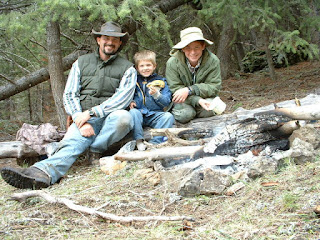



































































 d Blurry Katy
d Blurry Katy
















































